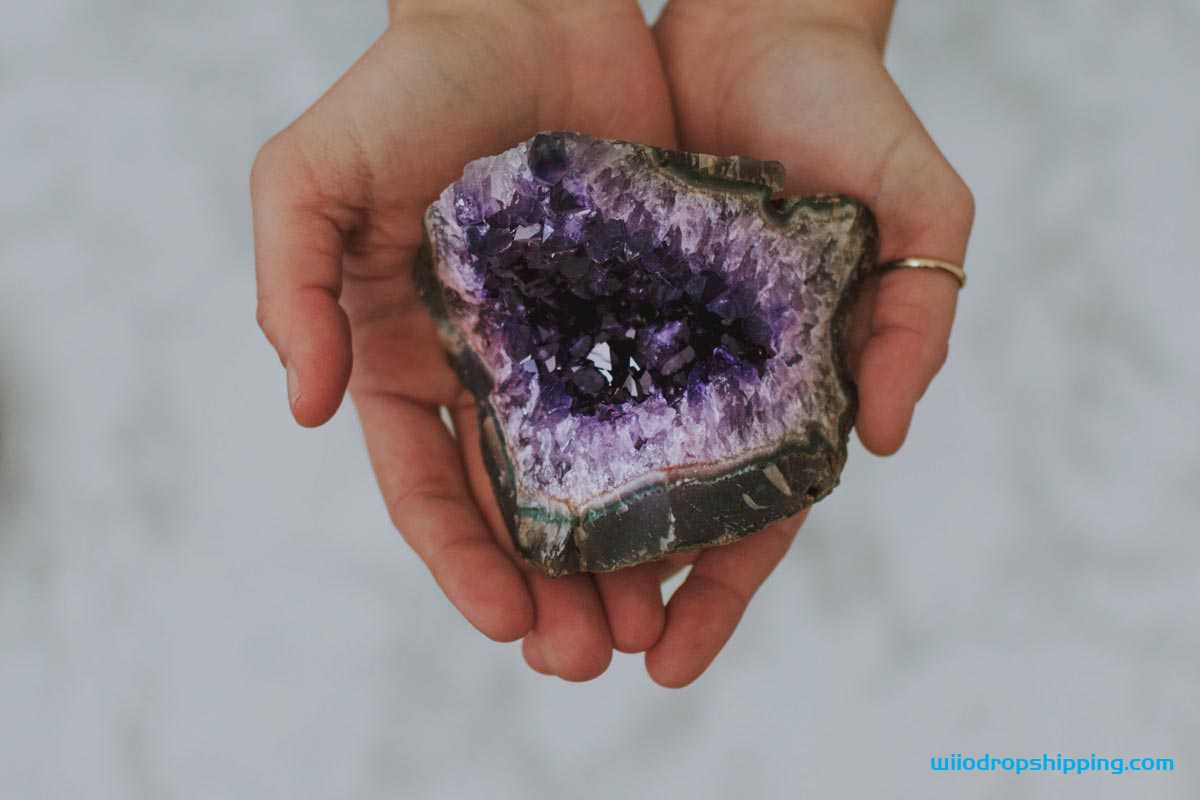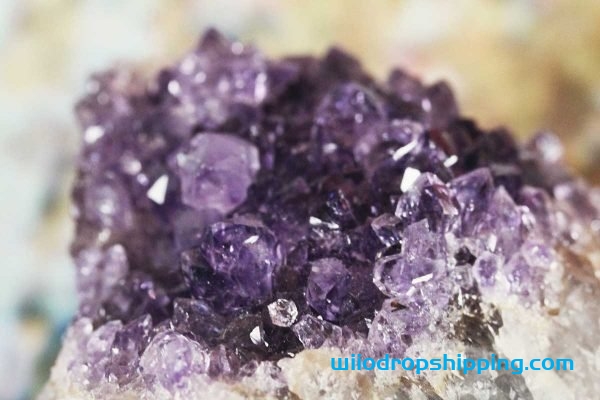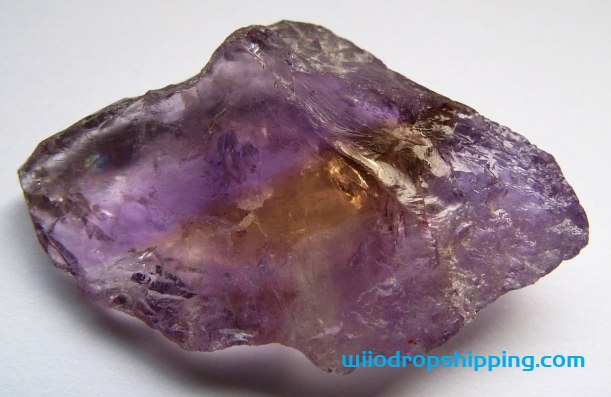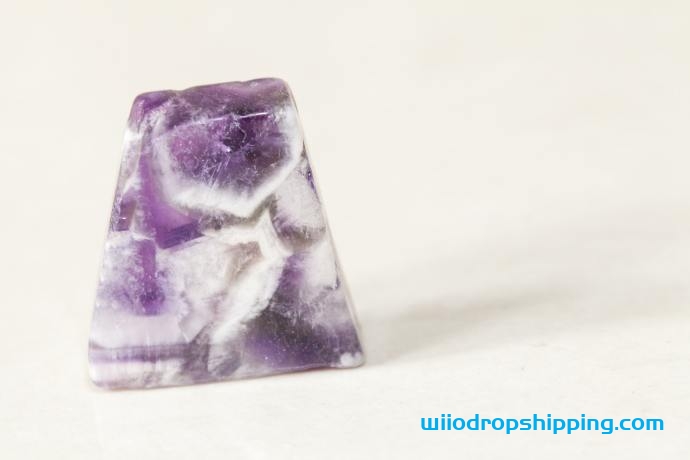Physical Address
304 North Cardinal St.
Dorchester Center, MA 02124


When it comes to purple gems, no other gemstone exceeds the popularity of amethyst. And here comes a need to learn how to tell if an amethyst stone is real or not easily.
Amethyst is one of the oldest gemstones known for being a talisman or protection against intoxication. It also possesses many other metaphysical properties that are oriented toward healing and releasing negative energies.
Unbeknownst to many, amethyst is a type of quartz that takes its color from chemical inclusions, including the mineral iron and manganese.
If you know the process of crystallization and mineralization, you would already know that the colors of gems are primarily dependent on the additional elements that get into the inner structure of the flowers as they are forming. Simple changes to the chemical composition of gemstones can result in speckles or bands of color forming throughout a given specimen.

Authentic Amethyst gems should have some imperfections and different shades of purple. An Amethyst gem that is one solid color is most likely fake. Real Amethyst stones will have color zoning including shades of white and blue along with purple. A real Amethyst gem won’t have any bubbles but may have threads and impurities beneath the surface.
As it’s one of the most popular gems out there, it means that synthetic Amethyst can be very common. The gemstone world is rife with synthetic lab-created crystals and natural stones. To help you decide which kind of stone you want, we take a look at all the ways to unravel fake crystals from the real thing.
If Amethyst isn’t the stone for you, take a look at our healing guide to essential gemstones and find a crystal that calls you home.
One of the best ways to tell if an Amethyst is real is to look at the coloring. A real Amethyst will have color zoning rather than being one block color. The color of Amethyst is usually a purple or violet hue. Some stones will be so dark that they appear a wine-shaded red or black and others are pale as lavender and shot with shades of white and blue.
Within the folds of this, it’s also worth knowing that there are different varieties of Amethyst and this can affect the coloring too. Ametrine, for example, is the marriage of Citrine and Amethyst which leads to sharp banding on the gem. Amethyst Quartz can also have milky and translucent shading especially around the bottom of the crystal. When you hold the quartz crystal up to the light, you may catch sight of all the different shades swimming and glinting beneath the faceted surface. This is a sign of a true Amethyst.
If you have a faux Amethyst quartz, then it could be a crystal shot with a dye to look like the real thing. This happens when jewelers or sellers try to pass off similar-looking quartz pieces as Amethyst and seal cracks with injected dye to hide any signs of fakery. If you want to check if the quartz is an authentic Amethyst or not, look closely at the gem and see if there are any areas where the cracks have small qualities of pigments. Amethyst geodes and quartzes that have a very intense color are also likely to have been dyed.
Gems and minerals are often formed in intense environments with plenty of pressure and high heat. It’s only natural that this would affect the clarity and cause bubbles beneath the surface and areas of discoloration. This is true for a lot of stones, but it’s not true for Amethyst. Amethyst is a quartz stone meaning that you are more likely to see threads beneath the surface rather than bubbles. In fact, in quartz – bubbles and discolorations would actually be quite rare. Take a magnifying glass to your Amethyst and check to see what sits beneath the surface, if you see bubbles then it may not be quartz in the first place, and if it isn’t quartz, it certainly isn’t an Amethyst. Amethysts that are real crystals should be eye clear (that doesn’t necessarily mean crystal clear). If you hold your Amethyst up to the light, you should be able to glance right through it without seeing bubbles or big discoloration.
Once you have looked carefully at the color and clarity of the gem, it’s time to consider the cut. Amethysts can come in many different shapes as it’s an easy stone to cut. So, just because you see Amethyst carved into hearts doesn’t mean it’s a fake. Another common cut for true Amethyst is the rounder shape as jewelers will do this to hide any imperfections in the original. Don’t be shy of asking for a magnifying glass to study the circular Amethysts so you can check for clarity and how the color is distributed throughout the gem as outlined above. If you buy a cut Amethyst it will usually have a smooth polished finish.
You don’t have to just rely on your eyes when trying to figure out if your Amethyst is the real deal, there is also a specific gravity test that you can turn to. It takes a little longer to figure out but it’s definitely worthwhile if you want to be absolutely sure. You are going to need a set of scales, some water, and a beaker for measuring. As true Amethyst has a gravity number of around 2.65, this test measures exactly that. Here’s how to do it…
The hardness test is always a great marker – for any crystal, not just Amethyst. Each crystal will have its own score on the Mohs hardness scale and knowing where Amethyst sits can help you to figure out if your gem is in alignment. The Mohs hardness scale ranges from 1-10 with 1 being the softest and 10 being the hardest. For example, a diamond is a 10, a blade is around a 5, a fingernail is around a 2, and talcum powder is 1. So where does Amethyst sit? Amethyst is a 7 meaning that it’s a pretty hard gemstone. Anything below a 7 on the Mohs hardness scale shouldn’t be able to cause damage to a true Amethyst stone. You can use your fingernail to scratch the surface of an Amethyst and see if you leave a mark. Theoretically, you could also use a blade or a knife but most jewelers probably wouldn’t dig that.
Don’t hold back when it comes to asking questions about your Amethyst. A good dealer shouldn’t brush you off when you are trying to flesh out the story of your Amethyst’s origins. This is a valuable question to ask as it may provide a little insight into the validity of your gem. Amethyst’s can be found all over the world, but they are usually sourced from Brazil, South Africa, Namibia and in the USA states of Arizona, Colorado, and the Carolinas. Of course, it doesn’t mean that an Amethyst that isn’t from these places is a fugazi, but it can be an indication when stacked up with other evidence.
Amethyst is a relatively affordable gemstone which is another reason it’s so popular in the crystal world. The price of Amethyst will certainly see some variation. Depending on the quality of the stone, whether it’s in raw or polished form, the weight, and the level of imperfections – all of this will affect the price of the stone. Really, you can expect real Amethyst to cost between $2 and $30+ per carat. As with buying anything, if a deal is too good to be true – then it probably isn’t the real deal after all. You should expect to pay no less than $20 for Amethyst from a reputable jewelers. If you see Amethyst for sale for less than this, you could be getting fleeced for a fakery.
Sometimes sellers like to get creative with the gems they are selling and while these exotic names can be alluring, they are often just masking the fact that the Amethyst isn’t real. You may see made-up names like Desert Amethyst, Lithia Amethyst, Japanese Amethyst, and Bengal Amethyst. While it’s easy to think these could just be variations of Amethyst, they don’t exist and are probably a sign that real Amethyst isn’t being used.
Amethyst is graded into categories to help potential buyers and finders figure out just how good their stone is. You see a similar practice with diamonds. There are three different categories for figuring out how good Amethyst is and these will take into consideration everything from cut to color, carat to clarity. The highest grade of Amethyst will be practically flawless whereas the lower grade can have visual inclusions. Of course, the three grades of Amethyst apply to real Amethyst rather than lab-grown synthetic Amethyst.
This is the biggest range of Amethysts and applies to up to 50- 75% of the gems out there. While the lowest of the three spectrums, natural AA Amethyst is nothing to sniff at. Stones that fall into this category tend to have heavy or moderate inclusions and have a color scale closer to light purple. You will normally buy this kind of Amethyst in small high street jewelers.
The next grade up of Amethyst, natural AAA applies to around 20-30% of Amethysts. You can see slight inclusions in these stones and they have a medium purple color. You will find these Amethyst gems in higher scale family and independent jewelers.
At the top of the Amethyst class comes the natural AAAA grade. These kinds of Amethyst make up only around 10% of the market, and they are as close to perfect as you can get. These gems will look as clear as can be to the naked eye, they are beautifully cut, and they are a shade of dreamy dark purple. As it’s so flawless, you will struggle to see imperfections but fear not, if you are buying from a top tier jeweler at a high price it’s sure to be dazzlingly real.
Hopefully we have gifted you with all the information you need to take a deeper look at your Amethyst stone. Owning a true and honest Amethyst is an absolute dream as they radiate with high vibrations, loving energy, and the promise of balance for body, mind, and soul. As long as you look for imperfections, don’t get swayed by low costs or audacious marketing, and apply the four C’s rule of color, cut, clarity, and carat, you should find the perfect Amethyst that vibes with you.
What’s your experience buying gemstones? Have you ever been unsure of what’s real and what’s fake? Share all your comments with us so together, we can build a brilliant portfolio of what to look for when finding crystals.

If a crystal containing violet and yellow hues is being marketed as an amethyst, it is not entirely wrong in its claims. While the stone is a rarer variety of amethyst, it is extremely prone to synthetic production. This is the fascinating world of the ametrine crystal.
Under very rare heat and pressure conditions in the earth’s mantle at the time of quartz formation, the iron impurities that lend amethyst its violet hue may occur alongside other impurities which give citrine its characteristic yellow hue.
When these impurities fuse in the quartz, the crystal formation so obtained is called an Ametrine.
Ametrine, as the name suggests, is a natural combination of citrine and amethyst. It is a member of the hexagonal crystal system but may be found as celestial crystals or in its massive form.

It is a purple and white, banded variety of massive quartz.These are not Fake Amethysts, but they are called Chevron Amethyst.
The purple bands are characteristic of and share the microscopic crystal structure of amethyst while the white bands resemble the properties of milky quartz.
The highest quality pieces of this variety of Amethyst occur in South Africa, but significant deposits are also found in India. Chevron amethyst is also sometimes referred to as banded amethyst or as Cape amethyst. They are typically opaquer than other amethysts.
Amethysts are a great place to start as a crystal collector because they’re plentiful; there’s a wide variety they can be had at relatively inexpensive amounts.
Despite its natural abundance, the economic viability of mass-producing amethysts has made it one of the most common and widely imitated crystals of all times.
In this article, we have covered a few of the several types of amethysts found in nature and how to identify their imitations. We also have identified three distinctive traits of amethysts crystal which can be used to differentiate them from their respective fakes: color, cut, and size.
These buying practices would help you while buying amethysts. Share this post to whom you care.